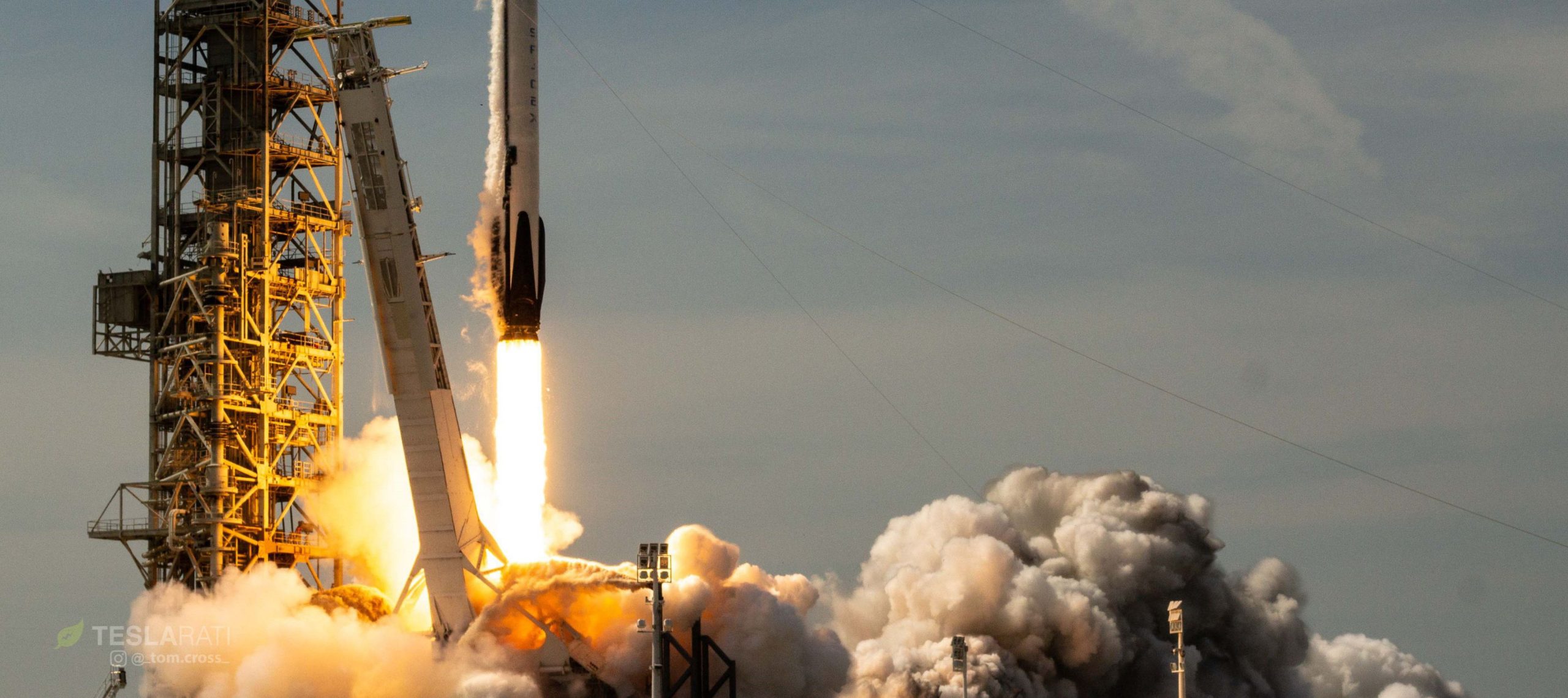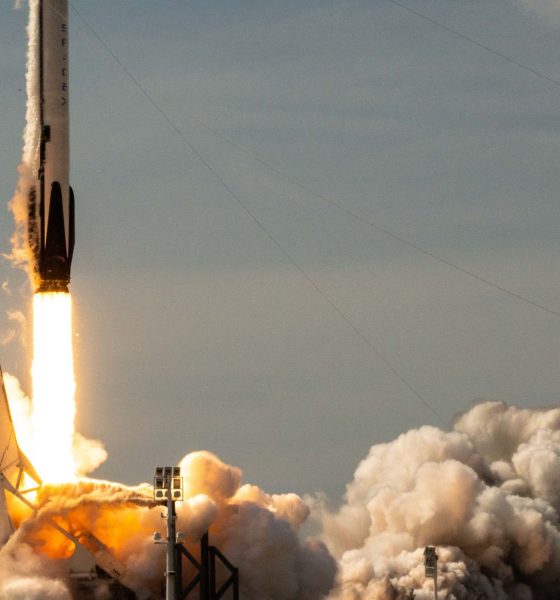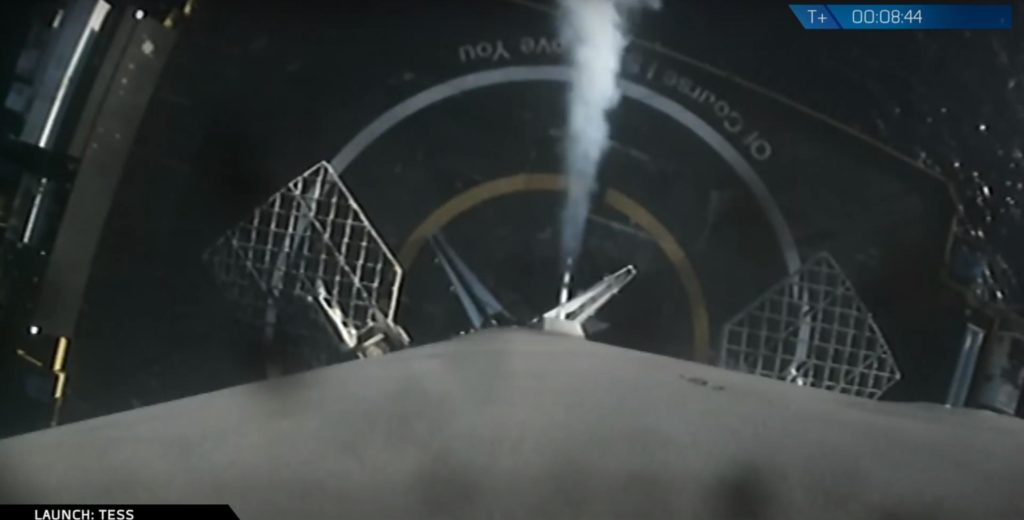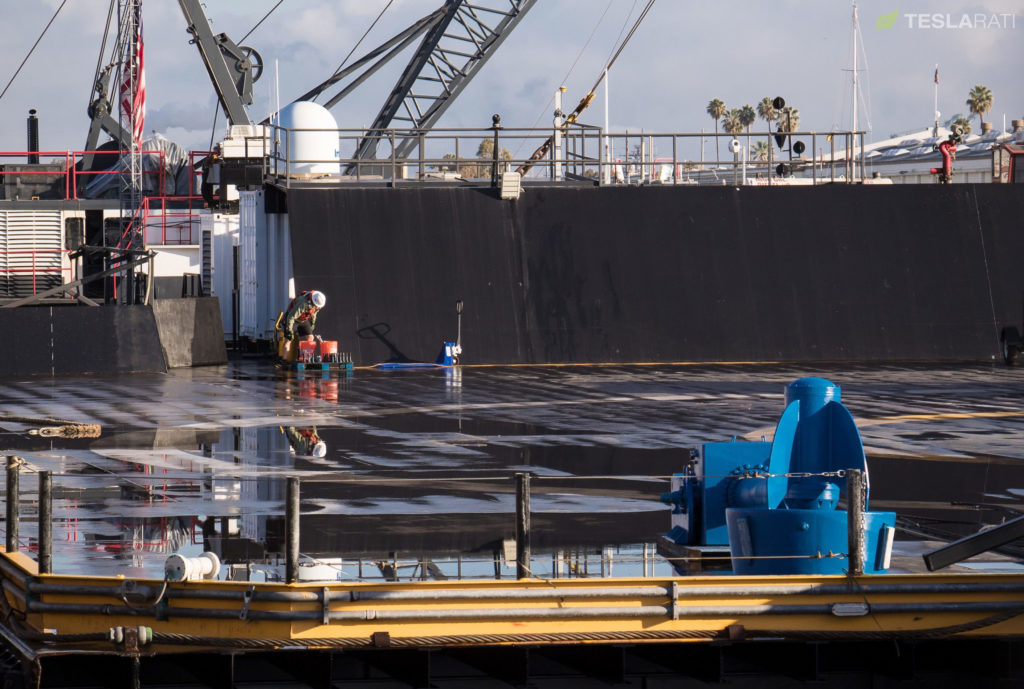

News
SpaceX’s Falcon 9 Block 5 fleet preps for dual drone ship booster landings
SpaceX engineers and technicians have just completed the second on-pad static fire of a Falcon 9 Block 5 booster, and another test is scheduled on the opposite coast for a different upgraded booster in roughly two days.
Penciled in on July 22 and July 25, these imminent back to back launches will mark the effective beginning of the highly-reusable Block 5 era now that all older versions have flown for the last time. Crucially, the practice of intentionally expending reused boosters will almost certainly come to an end for the indefinite future, beginning with these next missions. Both new cores will land aboard drone ship pair Just Read The Instructions (JRTI; West Coast) and Of Course I Still Love You (OCISLY; East Coast), and both autonomous vessels will be simultaneously stationed at sea for the second time ever.
Static fire test of Falcon 9 complete—targeting early morning launch on Sunday, July 22 of Telstar 19 VANTAGE from Pad 40 in Florida.
— SpaceX (@SpaceX) July 18, 2018
This rare dual drone ship deployment will likely become a regular occurrence for SpaceX Falcon 9 and Falcon Heavy recoveries over the course of the rest of 2018 and 2019, as higher rates of launch from both East and West coast launch facilities and the unlikelihood of a Block 5 booster being expended will translate to a much greater need for the giant rocket recovery vessels.
In fact, the 7-10 days it takes drone ships to travel from their ports of call to booster landing points and back to port again will likely be the most insurmountable constraint on launch cadence, at least for the Falcon family – high energy missions could only be completed every ten or so days on the East Coast, at least until a third drone ship is brought online. To be named A Shortfall of Gravitas (ASoG), a third autonomous spaceport drone ship (ASDS) is in fact planned as an expansion of SpaceX’s fleet, although it’s unknown if the vessel is under construction now, nor when exactly it’s expected to enter service.
SpaceX’s next three missions from its Florida-based LC-40 pad all happen to feature Block 5 Falcon 9 boosters tasked with placing heavy communications satellites in high-energy orbits, and all three launches are currently paced roughly two weeks apart – July 22, August 2, and August 18. That consistent two-week cadence on SpaceX’s launch schedule is for the most part driven equally by launchpad readiness and drone ship availability, both of which require some amount of refurbishment or maintenance after launches/landings.
On the West Coast will be the launch of Iridium NEXT-7 on July 25, carrying ten Iridium NEXT satellites atop a Block 5 booster. That booster – as well as at least two of the three East coast boosters – will be fresh from the factory, conducting (hopefully) the first of many future missions apiece. Excitingly, the planned recovery attempt after Iridium-7 will bring to an end a nearly 10-month drought of rocket landings aboard drone ship JRTI. Further, it looks like chances are good that Iridium-7 will also see recovery vessel Mr Steven break in his massive new net and arms in with an attempted catch of a Falcon 9 fairing half.
- A SpaceX technician works aboard the rain-soaked drone ship Just Read The Instructions, March 2018. (Pauline Acalin)
- The drone ship Of Course I Still Love You spotted in Port Canaveral, FL last December. (Instagram /u/ johnabc123)
- Mr Steven testing his new net in a series of sea trials, July 11
Follow us for live updates, peeks behind the scenes, and photos from Teslarati’s East and West Coast photographers.
Teslarati – Instagram – Twitter
Tom Cross – Twitter
Pauline Acalin – Twitter
Eric Ralph – Twitter

Elon Musk
Elon Musk’s X will start using a Tesla-like software update strategy
The initiative seems designed to accelerate updates to the social media platform, while maintaining maximum transparency.

Elon Musk’s social media platform X will adopt a Tesla-esque approach to software updates for its algorithm.
The initiative seems designed to accelerate updates to the social media platform, while maintaining maximum transparency.
X’s updates to its updates
As per Musk in a post on X, the social media company will be making a new algorithm to determine what organic and advertising posts are recommended to users. These updates would then be repeated every four weeks.
“We will make the new 𝕏 algorithm, including all code used to determine what organic and advertising posts are recommended to users, open source in 7 days. This will be repeated every 4 weeks, with comprehensive developer notes, to help you understand what changed,” Musk wrote in his post.
The initiative somewhat mirrors Tesla’s over-the-air update model, where vehicle software is regularly refined and pushed to users with detailed release notes. This should allow users to better understand the details of X’s every update and foster a healthy feedback loop for the social media platform.
xAI and X
X, formerly Twitter, has been acquired by Elon Musk’s artificial intelligence startup, xAI last year. Since then, xAI has seen a rapid rise in valuation. Following the company’s the company’s upsized $20 billion Series E funding round, estimates now suggest that xAI is worth tens about $230 to $235 billion. That’s several times larger than Tesla when Elon Musk received his controversial 2018 CEO Performance Award.
As per xAI, the Series E funding round attracted a diverse group of investors, including Valor Equity Partners, Stepstone Group, Fidelity Management & Research Company, Qatar Investment Authority, MGX, and Baron Capital Group, among others. Strategic partners NVIDIA and Cisco Investments also continued support for building the world’s largest GPU clusters.
News
Tesla FSD Supervised wins MotorTrend’s Best Driver Assistance Award
The decision marks a notable reversal for the publication from prior years, with judges citing major real-world improvements that pushed Tesla’s latest FSD software ahead of every competing ADAS system.

Tesla’s Full Self-Driving (Supervised) system has been named the best driver-assistance technology on the market, earning top honors at the 2026 MotorTrend Best Tech Awards.
The decision marks a notable reversal for the publication from prior years, with judges citing major real-world improvements that pushed Tesla’s latest FSD software ahead of every competing ADAS system. And it wasn’t even close.
MotorTrend reverses course
MotorTrend awarded Tesla FSD (Supervised) its 2026 Best Tech Driver Assistance title after extensive testing of the latest v14 software. The publication acknowledged that it had previously criticized earlier versions of FSD for erratic behavior and near-miss incidents, ultimately favoring rivals such as GM’s Super Cruise in earlier evaluations.
According to MotorTrend, the newest iteration of FSD resolved many of those shortcomings. Testers said v14 showed far smoother behavior in complex urban scenarios, including unprotected left turns, traffic circles, emergency vehicles, and dense city streets. While the system still requires constant driver supervision, judges concluded that no other advanced driver-assistance system currently matches its breadth of capability.
Unlike rival systems that rely on combinations of cameras, radar, lidar, and mapped highways, Tesla’s FSD operates using a camera-only approach and is capable of driving on city streets, rural roads, and freeways. MotorTrend stated that pure utility, the ability to handle nearly all road types, ultimately separated FSD from competitors like Ford BlueCruise, GM Super Cruise, and BMW’s Highway Assistant.
High cost and high capability
MotorTrend also addressed FSD’s pricing, which remains significantly higher than rival systems. Tesla currently charges $8,000 for a one-time purchase or $99 per month for a subscription, compared with far lower upfront and subscription costs from other automakers. The publication noted that the premium is justified given FSD’s unmatched scope and continuous software evolution.
Safety remained a central focus of the evaluation. While testers reported collision-free operation over thousands of miles, they noted ongoing concerns around FSD’s configurable driving modes, including options that allow aggressive driving and speeds beyond posted limits. MotorTrend emphasized that, like all Level 2 systems, FSD still depends on a fully attentive human driver at all times.
Despite those caveats, the publication concluded that Tesla’s rapid software progress fundamentally reshaped the competitive landscape. For drivers seeking the most capable hands-on driver-assistance system available today, MotorTrend concluded Tesla FSD (Supervised) now stands alone at the top.
News
Elon Musk’s Grokipedia surges to 5.6M articles, almost 79% of English Wikipedia
The explosive growth marks a major milestone for the AI-powered online encyclopedia, which was launched by Elon Musk’s xAI just months ago.

Elon Musk’s Grokipedia has grown to an impressive 5,615,201 articles as of today, closing in on 79% of the English Wikipedia’s current total of 7,119,376 articles.
The explosive growth marks a major milestone for the AI-powered online encyclopedia, which was launched by Elon Musk’s xAI just months ago. Needless to say, it would only be a matter of time before Grokipedia exceeds English Wikipedia in sheer volume.
Grokipedia’s rapid growth
xAI’s vision for Grokipedia emphasizes neutrality, while Grok’s reasoning capabilities allow for fast drafting and fact-checking. When Elon Musk announced the initiative in late September 2025, he noted that Grokipedia would be an improvement to Wikipedia because it would be designed to avoid bias.
At the time, Musk noted that Grokipedia “is a necessary step towards the xAI goal of understanding the Universe.”
Grokipedia was launched in late October, and while xAI was careful to list it only as Version 0.1 at the time, the online encyclopedia immediately earned praise. Wikipedia co-founder Larry Sanger highlighted the project’s innovative approach, noting how it leverages AI to fill knowledge gaps and enable rapid updates. Netizens also observed how Grokipedia tends to present articles in a more objective manner compared to Wikipedia, which is edited by humans.
Elon Musk’s ambitious plans
With 5,615,201 total articles, Grokipedia has now grown to almost 79% of English Wikipedia’s article base. This is incredibly quick, though Grokipedia remains text-only for now. xAI, for its part, has now updated the online encyclopedia’s iteration to v0.2.
Elon Musk has shared bold ideas for Grokipedia, including sending a record of the entire knowledge base to space as part of xAI’s mission to preserve and expand human understanding. At some point, Musk stated that Grokipedia will be renamed to Encyclopedia Galactica, and it will be sent to the cosmos.
“When Grokipedia is good enough (long way to go), we will change the name to Encyclopedia Galactica. It will be an open source distillation of all knowledge, including audio, images and video. Join xAI to help build the sci-fi version of the Library of Alexandria!” Musk wrote, adding in a later post that “Copies will be etched in stone and sent to the Moon, Mars and beyond. This time, it will not be lost.”












